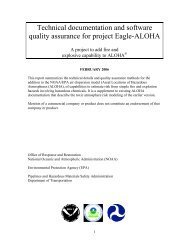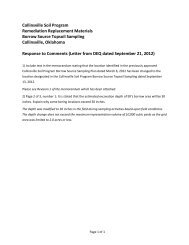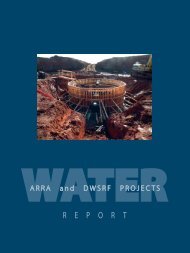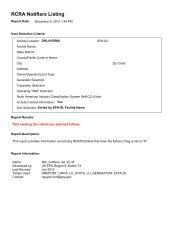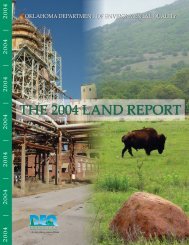Oklahoma Gas & Electric Muskogee Generating Station Best ...
Oklahoma Gas & Electric Muskogee Generating Station Best ...
Oklahoma Gas & Electric Muskogee Generating Station Best ...
Create successful ePaper yourself
Turn your PDF publications into a flip-book with our unique Google optimized e-Paper software.
<strong>Oklahoma</strong> <strong>Gas</strong> & <strong>Electric</strong><br />
<strong>Muskogee</strong> <strong>Generating</strong> <strong>Station</strong> – BART Determination<br />
May 28, 2008<br />
1.0 INTRODUCTION<br />
On July 6, 2005, the U.S. Environmental Protection Agency (EPA) published the final “Regional<br />
Haze Regulations and Guidelines for <strong>Best</strong> Available Retrofit Technology Determinations” (the<br />
“Regional Haze Rule” 70 FR 39104). EPA issued the Regional Haze Rule under the authority and<br />
requirements of sections 169A and 169B of the Clean Air Act (CAA). Sections 169A and 169B<br />
require EPA to address regional haze visibility impairment in 156 federally-protected parks and<br />
wilderness areas (Class I Areas). As mandated by the CAA, the Regional Haze Rule requires<br />
certain large stationary sources to install the best available retrofit technology (BART) to reduce<br />
emissions of pollutants that may impact visibility in a Class I Area.<br />
The Regional Haze Rule requires certain States, including <strong>Oklahoma</strong>, to develop programs to<br />
assure reasonable progress toward meeting the national goal of preventing any future, and<br />
remedying any existing, impairment of visibility in Class I Areas. The Regional Haze Rule requires<br />
states to submit a plan to implement the regional haze requirements (the Regional Haze SIP). The<br />
Regional Haze SIP must provide for a BART analysis of any existing stationary facility that might<br />
cause or contribute to impairment of visibility in a Class I Area. To address the requirements for<br />
BART, <strong>Oklahoma</strong> must:<br />
� Identify all BART-eligible sources within the State.<br />
� Determine whether each BART-eligible source emits any air pollutant which may<br />
reasonably be anticipated to cause or contribute to any impairment of visibility in a<br />
Class I Area. BART-eligible sources which may reasonably be anticipated to cause or<br />
contribute to visibility impairment are classified as BART-applicable sources.<br />
� Require each BART-applicable source to identify, install, operate, and maintain BART<br />
controls.<br />
1.1 OG&E’s <strong>Muskogee</strong> <strong>Generating</strong> <strong>Station</strong><br />
OG&E’s <strong>Muskogee</strong> <strong>Generating</strong> <strong>Station</strong> is located at 5501 Three Forks Road near <strong>Muskogee</strong>,<br />
<strong>Oklahoma</strong>. The station has a total of four (4) generating units designated as <strong>Muskogee</strong> Units 3, 4, 5<br />
and 6. <strong>Muskogee</strong> Unit 3, which became operational in 1956, is a nominal 173-MW gas-fired unit.<br />
<strong>Muskogee</strong> Units 4, 5 and 6 are nominal 572-MW (gross) coal-fired units. Construction of<br />
<strong>Muskogee</strong> Units 4 & 5 commenced in the early 1970s, with Unit 4 coming on-line in 1977 and Unit<br />
5 coming on-line in 1978. Construction commenced on <strong>Muskogee</strong> Unit 6 in 1980, and Unit 6<br />
commenced commercial operation in mid-1984. All three coal-fired units at the <strong>Muskogee</strong><br />
<strong>Generating</strong> <strong>Station</strong> are dry bottom tangentially-fired pulverized coal (PC) boilers. The boilers fire<br />
subbituminous coal as their primary fuel, and are equipped with electrostatic precipitators for<br />
particulate control.<br />
3



